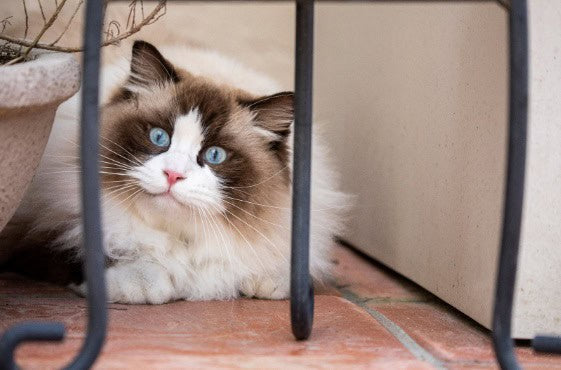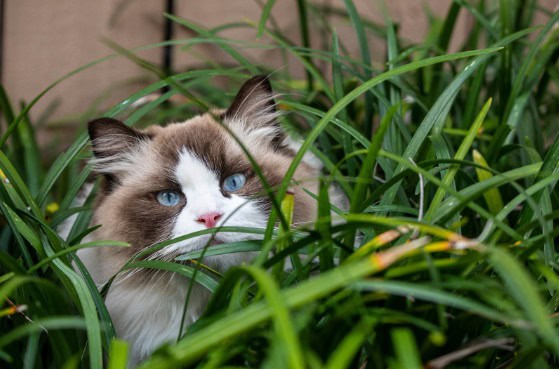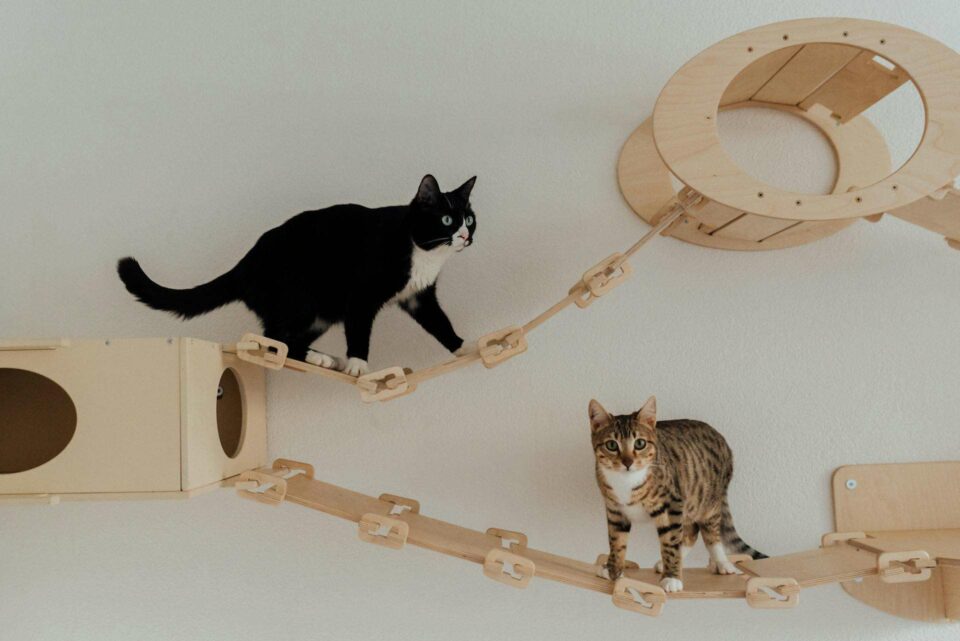
The Enigmatic Stare: Decoding Why Cats Stare at You
Cats often captivate us with their mysterious stares, leaving many cat owners pondering the meaning behind those intense gazes. Understanding why cats stare can help us better connect with our feline friends and respond to their silent communication. This article delves into the reasons behind various types of cat stares, from seeking attention to expressing curiosity or discomfort, and offers insights into how we can interpret and react to our cat's silent messages.
Key Takeaways
- Cats use staring as a form of communication, which can indicate a desire for attention, curiosity, or even stress and anxiety.
- Vocalizations such as meowing, along with body language and environmental cues, provide context to understand a cat's stare and underlying needs.
- Responding appropriately to a cat's stare involves recognizing the message being conveyed and knowing the do's and don'ts to strengthen the human-cat bond.
Understanding Feline Gazes: The Mystery Behind Cat Stares
The Attention-Seeking Stare: When Your Cat Wants to Be Noticed
Have you ever wondered why do cats stare at you with such intensity? It's not just a quirky behavior; it's a form of communication. When your cat fixes their gaze on you, it could be a plea for attention. They might be signaling that they want to play, they're ready for some affection, or perhaps they're simply reminding you that it's time for their meal.
Cats are masters of pulling focus. They know exactly how to get you to notice them, whether through a soft meow or a more persistent vocal performance. This behavior can be a learned one; if they've noticed that staring or meowing gets your attention, they'll repeat it. It's their way of saying, 'Hey, look at me!'
Here are a few tips to understand this attention-seeking stare:
- Observe the context: Are they meowing or is it mealtime?
- Pay attention to their body language: Are they ready to play or do they seem to need comfort?
- Respond appropriately: Give them the attention they seek, but be mindful not to reinforce excessive meowing if it becomes disruptive.
Related: THE TRUTH BEHIND YOUR CAT’S BEHAVIOR
The Curious Observer: Deciphering the Silent Watcher
Have you ever caught your cat fixating on you with an unwavering gaze, as if trying to unravel the mysteries of the universe? This silent watcher is not plotting your demise but is likely driven by pure curiosity. Cats are naturally inquisitive creatures, and your actions can be fascinating to them.
Their stare can be a form of silent communication, seeking to understand their environment and the beings within it. It's important to observe the context of their stare. Are they sitting comfortably with a relaxed posture, or is their body tense? Here are a few things to consider when your feline friend is giving you 'the look':
- Their environment: Is there something new or different in the room?
- Your behavior: Have you been acting differently, perhaps busier than usual?
- Time of day: Are they more attentive during certain times, possibly when they're usually fed or played with?
Understanding these factors can help you decode the silent messages your cat is sending. Remember, patience is key when living with a curious observer. And if you're concerned about changes in their behavior, such as increased anxiety, resources like Gou Gou Pets offer insights on cat anxiety signs, symptoms, and causes, along with pet products to help manage their stress.
Discover tranquility for your pet and unravel the enigmatic stare with our calming anxiety oil, tailored to soothe your cat's nerves. Foster understanding and harmony in your feline relationship while providing them with the care they need.
The Stare of Discontent: Recognizing Signs of Stress or Anxiety
When your cat fixes you with a stare that seems tinged with unease, it's important to recognize that this could be a sign of stress or anxiety. Cats are creatures of habit, and even minor changes in their environment can be unsettling. Look for other signs of distress, such as a decrease in appetite, an increase in hiding behavior, or excessive grooming. These symptoms, coupled with a persistent stare, suggest that your cat may be feeling insecure or anxious.
Stress in cats can stem from various sources, including new family members, shifts in the household, or even a simple rearrangement of furniture. Remember, your cat's emotional well-being is as crucial as their physical health. If you notice these behaviors, consider providing a quiet, safe space for your cat to retreat to. Additionally, maintaining a consistent routine can help alleviate their anxiety. Should these signs persist, it's wise to consult with your veterinarian to rule out any underlying health issues.
Responding to your cat's stare with gentle reassurance can also be beneficial. A calm voice, a soft pat, or some quality cuddle time can go a long way in soothing your feline friend. However, be mindful not to overwhelm them with attention, as this could exacerbate their stress. Finding the right balance is key to helping your cat feel secure once again.
Related: ANXIETY IN CATS: IDENTIFYING, MANAGING, AND SOOTHING FELINE STRESS

Communicating Without Words: Interpreting Your Cat's Silent Messages
The Meow Behind the Stare: Vocal Clues to Your Cat's Thoughts
While your cat's stare may seem inscrutable, the sounds that accompany it can offer valuable insights into its thoughts and emotions. Decode your cat's behavior by listening closely to the meows, purrs, growls, and hisses that often accompany their gaze. These vocalizations can vary in pitch, length, and frequency, and each nuance can reveal a different need or desire.
For instance, a high-pitched meow might indicate that your cat is greeting you or requesting attention, while a low-pitched growl could be a warning to stay away. Paying attention to these vocal clues can help you better understand and respond to your cat's silent messages. Here are some tips to interpret the sounds your cat makes:
- A short, soft purr usually signifies contentment and may accompany a relaxed stare.
- Repeated meows could be a sign of hunger or the desire to play.
- A long, drawn-out meow might signal distress or discomfort.
Remember, each cat is unique, and learning the specific vocal language of your feline friend will take time and observation. By tuning into these sounds, you'll be better equipped to meet your cat's needs and strengthen the bond between you.
Related: NATURAL PAIN RELIEF FOR CATS: HOLISTIC APPROACHES FOR COMFORT
Physical Context: Body Language and Environmental Cues
While your cat's stare may seem enigmatic, it's often accompanied by a symphony of body language that can provide insight into their mood and intentions. Observe the position of their ears, tail, and whiskers to get a clearer picture of what they're trying to communicate. For instance, a tail that's flicking back and forth could indicate irritation, while purring combined with a soft gaze might mean contentment.
Consider the environment as well. A cat staring at you from a high perch may simply be surveying their kingdom, while one that maintains eye contact at ground level could be seeking your attention or initiating play. Remember, context is key when interpreting your feline friend's silent messages.
To better understand your cat's communication:
- Pay attention to their posture and any subtle changes.
- Note the position of their tail and ears.
- Look for accompanying vocalizations or changes in their environment.
- Reflect on recent interactions or changes in routine that might affect their behavior.
Experience the serenity in your pet's gaze with our Calming Shampoo, thoughtfully formulated for your furry friend. Embrace tranquility in every glance—treat your beloved companion to a soothing grooming experience today.
Responding to the Stare: Do's and Don'ts for Cat Owners
When your cat fixes you with a steady gaze, it's important to respond appropriately to maintain a healthy relationship and ensure their well-being. Create a serene environment for your cat by providing hideaways, playing calming music, and maintaining a consistent routine. Respect their need for solitude and introduce new elements slowly to reduce stress. Consider multiple litter trays for comfort.
Interpreting your cat's stare can be challenging, but remember that patience is key. Here are some do's and don'ts to guide you:
- Do take the time to observe your cat's body language in conjunction with the stare to better understand their needs.
- Don't stare back aggressively, as this can be perceived as a threat.
- Do offer a gentle blink or a slow nod to show affection and non-threatening intentions.
- Don't force interaction if your cat seems to want space; instead, give them the opportunity to come to you when they're ready.
Unlock the secrets of your feline friend's non-verbal cues with our insightful guide on 'Communicating Without Words: Interpreting Your Cat's Silent Messages'. Dive deeper into understanding your pet's behavior and enhance your bond. Don't miss out on our exclusive pet care products tailored for your cat's needs.
Visit Gou Gou Pets today and take advantage of our special offers, including free shipping on orders over $49 and a 15% discount when you leave a review. Connect with your cat on a whole new level and ensure their well-being with our holistic pet care solutions.

Understanding the Silent Language of Cats
The enigmatic stare of a cat can be a window into their complex communication methods. From seeking attention to expressing their needs, cats use their gaze as a powerful tool to interact with their human companions. Understanding the nuances behind why cats stare at us can enhance our relationship with these fascinating creatures, allowing us to respond more effectively to their silent cues. Whether they are conveying affection, curiosity, or a desire for interaction, recognizing the significance of a cat's stare can lead to a deeper and more harmonious bond between pet and owner.
Share
